Reliability Assessment of a Fault-Tolerant PV Multistring Inverter
Abstract
1. Introduction
2. Theory
2.1. Fault-Tolerant Converter
2.2. Component Failure Rates
2.3. Reliability Model
- State 0: All of semiconductor devices are operational; redundant and connecting devices (TRIACs) are inactive.
- State 1: One IGBT or diode on the DC-DC stage has failed; the redundant leg and corresponding TRIAC are activated.
- State 2: One IGBT or diode on the DC-AC stage has failed; the redundant leg and corresponding TRIAC are activated.
- State 3: A second IGBT or diode fails or the TRIAC activated in the previous states fails; the system shuts down.
3. Methods and Materials
4. Results and Discussion
5. Economic Impact Evaluation
6. Conclusions
Author Contributions
Funding
Acknowledgments
Conflicts of Interest
Appendix A. Adjustment Factors
| Variable | Description | Expression/Value | Comment |
|---|---|---|---|
| Capacitor failure rate | = 0.0259 | Units in FIT (failures/ h) | |
| Failure base rate | 0.00012 | Aluminium electrolytic capacitor | |
| Temperature factor | , where T is the capacitor operating temperature | ||
| Capacitance factor | , where C is the capacitance in | ||
| Voltage stress factor | - | ||
| Quality factor | 10 | Commercial | |
| Environment factor | 1 | Indoor operation | |
| Voltage stress ratio | and , where is the operating voltage and is the capacitor rated voltage | ||
| Capacitor failure rate | = 0.0533 | Units in FIT | |
| Failure base rate | 0.00051 | Metallized plastic film capacitor | |
| Temperature factor | |||
| Capacitance factor | |||
| Voltage stress factor | - | ||
| Quality factor | 10 | Commercial | |
| Environment factor | 1 | Indoor operation | |
| Voltage stress ratio | and | ||
| Inductor failure rate | = 0.000111 | Units in FIT | |
| failure base rate | 0.00003 | Fixed inductor | |
| Temperature factor | , where T is the inductor operating temperature | ||
| Quality factor | 3 | Lower than MIL-spec | |
| Environment factor | 1 | Indoor operation | |
| IGBT failure rate | = 2.93 | Units in FIT | |
| IGBT failure rate | = 2.77 | Units in FIT | |
| Failure base rate | 0.006 | Half of the of a MOSFET | |
| Temperature factor | and , where is the IGBT junction temperature and | ||
| Application factor | 10 | Power supply | |
| Quality factor | 8 | Plastic | |
| Environment factor | 1 | Indoor operation | |
| Diode failure rate | = 1.14 | Units in FIT | |
| Diode failure rate | = 0.916 | Units in FIT | |
| Failure base rate | 0.025 | Fast recovery | |
| Temperature factor | and , where is the diode junction temperature and | ||
| Voltage stress factor | - | ||
| Construction factor | 1 | Metallurgically bonded | |
| Quality factor | 8 | Plastic | |
| Environment factor | 1 | Indoor operation | |
| Voltage stress ratio | and , where is the diode blocking voltage and is the diode rated voltage | ||
| TRIAC failure rate | = 0.0978 | Units in FIT | |
| TRIAC failure rate | = 0.0727 | Units in FIT | |
| Failure base rate | 0.0022 | All types | |
| Temperature factor | and , where is the TRIAC junction temperature and | ||
| Current rating factor | 4.8 | TRIAC rated at 50 A | |
| Voltage stress factor | - | ||
| Quality factor | 8 | Plastic | |
| Environment factor | 1 | Indoor operation | |
| Voltage stress ratio | and , where is the TRIAC blocking voltage and is the TRIAC rated voltage |
References
- Song, Y.; Wang, B. Survey on Reliability of Power Electronic Systems. IEEE Trans. Power Electron. 2013, 28, 591–604. [Google Scholar] [CrossRef]
- Wang, H.; Liserre, M.; Blaabjerg, F. Toward Reliable Power Electronics: Challenges, Design Tools, and Opportunities. IEEE Ind. Electron. Mag. 2013, 7, 17–26. [Google Scholar] [CrossRef]
- Golnas, A. PV System Reliability: An Operator’s Perspective. IEEE J. Photovolt. 2013, 3, 416–421. [Google Scholar] [CrossRef]
- Formica, T.J.; Khan, H.A.; Pecht, M.G. The Effect of Inverter Failures on the Return on Investment of Solar Photovoltaic Systems. IEEE Access 2017, 5, 21336–21343. [Google Scholar] [CrossRef]
- Lillo-Bravo, I.; González-Martínez, P.; Larrañeta, M.; Guasumba-Codena, J. Impact of Energy Losses Due to Failures on Photovoltaic Plant Energy Balance. Energies 2018, 11, 363. [Google Scholar] [CrossRef]
- Wu, R.; Blaabjerg, F.; Wang, H.; Liserre, M.; Iannuzzo, F. Catastrophic failure and fault-tolerant design of IGBT power electronic converters—An overview. In Proceedings of the 39th Annual Conference of the IEEE Industrial Electronics Society, Vienna, Austria, 10–13 November 2013; pp. 507–513. [Google Scholar]
- Choi, U.; Blaabjerg, F.; Lee, K. Study and Handling Methods of Power IGBT Module Failures in Power Electronic Converter Systems. IEEE Trans. Power Electron. 2015, 30, 2517–2533. [Google Scholar] [CrossRef]
- Kim, T.; Lee, W.; Hyun, D. Detection Method for Open-Circuit Fault in Neutral-Point-Clamped Inverter Systems. IEEE Trans. Ind. Electron. 2009, 56, 2754–2763. [Google Scholar]
- Yaghoubi, M.; Moghani, J.S.; Noroozi, N.; Zolghadri, M.R. IGBT Open-Circuit Fault Diagnosis in a Quasi-Z-Source Inverter. IEEE Trans. Ind. Electron. 2019, 66, 2847–2856. [Google Scholar] [CrossRef]
- Zhang, W.; Xu, D.; Enjeti, P.N.; Li, H.; Hawke, J.T.; Krishnamoorthy, H.S. Survey on Fault-Tolerant Techniques for Power Electronic Converters. IEEE Trans. Power Electron. 2014, 29, 6319–6331. [Google Scholar] [CrossRef]
- Karimi, S.; Poure, P.; Saadate, S. Fast power switch failure detection for fault tolerant voltage source inverters using FPGA. IET Power Electron. 2009, 2, 346–354. [Google Scholar] [CrossRef]
- Errabelli, R.R.; Mutschler, P. Fault-Tolerant Voltage Source Inverter for Permanent Magnet Drives. IEEE Trans. Power Electron. 2012, 27, 500–508. [Google Scholar] [CrossRef]
- Pradeep Kumar, V.V.S.; Fernandes, B.G. A Fault-Tolerant Single-Phase Grid-Connected Inverter Topology with Enhanced Reliability for Solar PV Applications. IEEE J. Emerg. Sel. Top. Power Electron. 2017, 5, 1254–1262. [Google Scholar] [CrossRef]
- Jamshidpour, E.; Poure, P.; Saadate, S. Photovoltaic Systems Reliability Improvement by Real-Time FPGA-Based Switch Failure Diagnosis and Fault-Tolerant DC–DC Converter. IEEE Trans. Ind. Electron. 2015, 62, 7247–7255. [Google Scholar] [CrossRef]
- Guilbert, D.; Gaillard, A.; N’Diaye, A.; Djerdir, A. Power switch failures tolerance and remedial strategies of a 4-leg floating interleaved DC/DC boost converter for photovoltaic/fuel cell applications. Renew. Energy 2016, 90, 14–27. [Google Scholar] [CrossRef]
- Poon, J.; Jain, P.; Konstantakopoulos, I.C.; Spanos, C.; Panda, S.K.; Sanders, S.R. Model-Based Fault Detection and Identification for Switching Power Converters. IEEE Trans. Power Electron. 2017, 32, 1419–1430. [Google Scholar] [CrossRef]
- Filba-Martinez, A.; Alepuz, S.; Busquets-Monge, S.; Luque, A.; Bordonau, J. An Intelligent Electronic Fuse (iFuse) to Enable Short-Circuit Fault-Tolerant Operation of Power Electronic Converters. TechRxiv 2020. [Google Scholar] [CrossRef]
- An, Q.; Sun, L.; Zhao, K.; Sun, L. Switching Function Model-Based Fast-Diagnostic Method of Open-Switch Faults in Inverters Without Sensors. IEEE Trans. Power Electron. 2011, 26, 119–126. [Google Scholar] [CrossRef]
- Kamel, T.; Biletskiy, Y.; Chang, L. Fault Diagnoses for Industrial Grid-Connected Converters in the Power Distribution Systems. IEEE Tran. Ind. Electron. 2015, 62, 6496–6507. [Google Scholar] [CrossRef]
- Im, W.; Kim, J.; Lee, D.; Lee, K. Diagnosis and Fault-Tolerant Control of Three-Phase AC–DC PWM Converter Systems. IEEE Trans. Ind. Appl. 2013, 49, 1539–1547. [Google Scholar] [CrossRef]
- Peuget, R.; Courtine, S.; Rognon, J. Fault detection and isolation on a PWM inverter by knowledge-based model. IEEE Trans. Ind. Appl. 1998, 34, 1318–1326. [Google Scholar] [CrossRef]
- Shahbazi, M.; Poure, P.; Saadate, S.; Zolghadri, M.R. FPGA-Based Reconfigurable Control for Fault-Tolerant Back-to-Back Converter Without Redundancy. IEEE Trans. Ind. Electron. 2013, 60, 3360–3371. [Google Scholar] [CrossRef]
- Huang, Z.; Wang, Z.; Zhang, H. Multiple Open-Circuit Fault Diagnosis Based on Multistate Data Processing and Subsection Fluctuation Analysis for Photovoltaic Inverter. IEEE Tran. Instrum. Meas. 2018, 67, 516–526. [Google Scholar] [CrossRef]
- Ribeiro, E.; Cardoso, A.J.M.; Boccaletti, C. Fault-Tolerant Strategy for a Photovoltaic DC-DC Converter. IEEE Trans. Power Electron. 2013, 28, 3008–3018. [Google Scholar] [CrossRef]
- Freire, N.M.A.; Estima, J.O.; Marques Cardoso, A.J. Open-Circuit Fault Diagnosis in PMSG Drives for Wind Turbine Applications. IEEE Trans. Ind. Electron. 2013, 60, 3957–3967. [Google Scholar] [CrossRef]
- Estima, J.O.; Freire, N.M.A.; Cardoso, A.J.M. Recent advances in fault diagnosis by Park’s vector approach. In Proceedings of the 2013 IEEE Workshop on Electrical Machines Design, Control and Diagnosis (WEMDCD), Paris, France, 11–12 March 2013; pp. 279–288. [Google Scholar]
- MIL-HDBK-217F. Reliability Prediction of Electronic Equipment. Available online: https://snebulos.mit.edu/projects/reference/MIL-STD/MIL-HDBK-217F-Notice2.pdf (accessed on 9 December 2020).
- Ristow, A.; Begovic, M.; Pregelj, A.; Rohatgi, A. Development of a Methodology for Improving Photovoltaic Inverter Reliability. IEEE Trans. Ind. Electron. 2008, 55, 2581–2592. [Google Scholar] [CrossRef]
- Song, Y.; Wang, B. A hybrid electric vehicle powertrain with fault-tolerant capability. In Proceedings of the 2012 Twenty-Seventh Annual IEEE Applied Power Electronics Conference and Exposition (APEC), Orlando, FL, USA, 5–9 February 2012; pp. 951–956. [Google Scholar]
- Sangwongwanich, A.; Yang, Y.; Sera, D.; Blaabjerg, F. Lifetime Evaluation of Grid-Connected PV Inverters Considering Panel Degradation Rates and Installation Sites. IEEE Trans. Power Electron. 2018, 33, 1225–1236. [Google Scholar] [CrossRef]
- Photong, C. A Current Source Inverter with Series AC Capacitors for Transformerless Grid-Tied Photovoltaic Applications. Ph.D. Thesis, University of Nottingham, Nottingham, UK, 2013. [Google Scholar]
- De Prada-Gil, M.; Domínguez-García, J.; Trilla, L.; Gomis-Bellmunt, O. Technical and economic comparison of various electrical collection grid configurations for large photovoltaic power plants. IET Renew. Power Gener. 2017, 11, 226–236. [Google Scholar] [CrossRef]

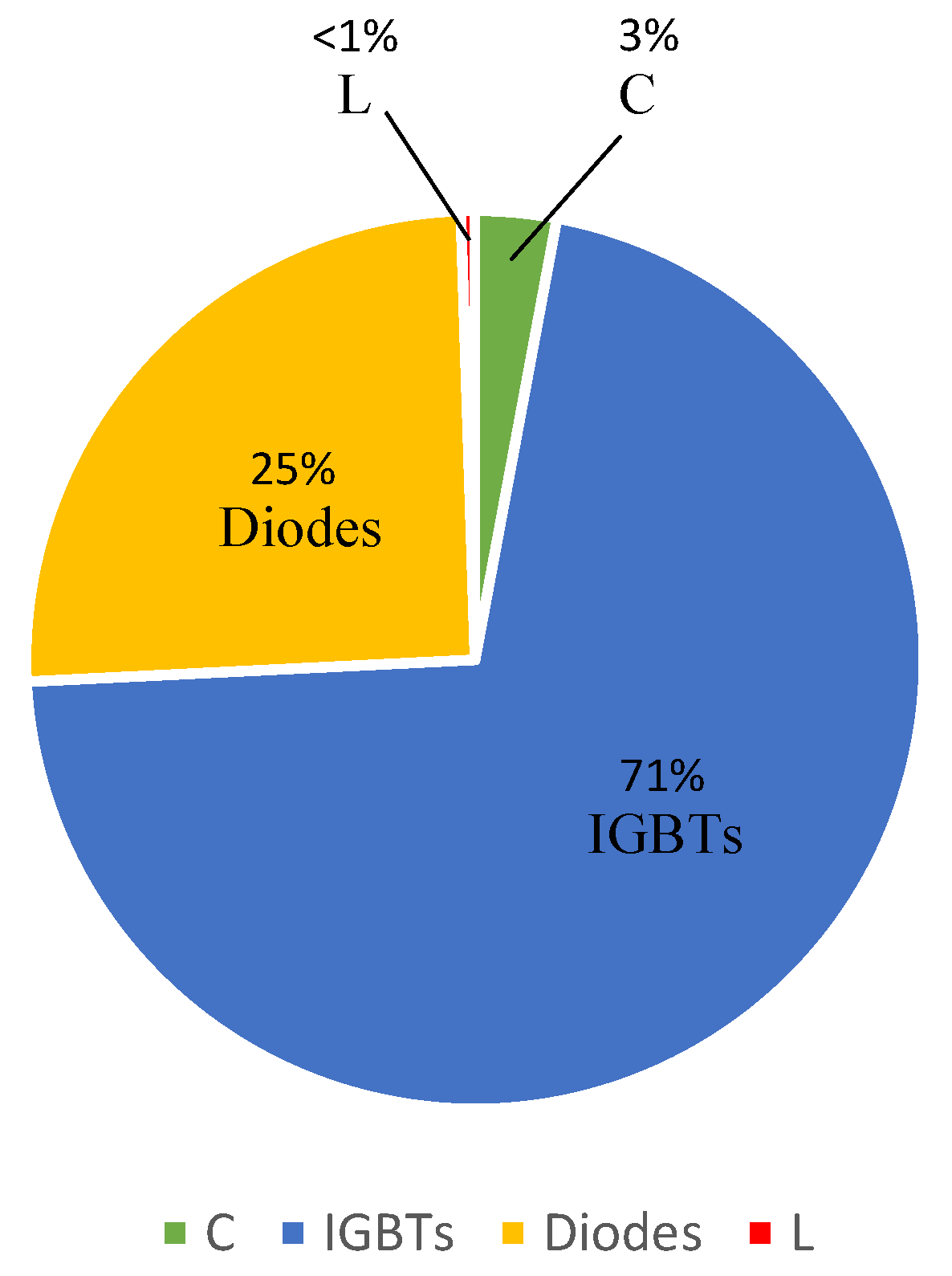
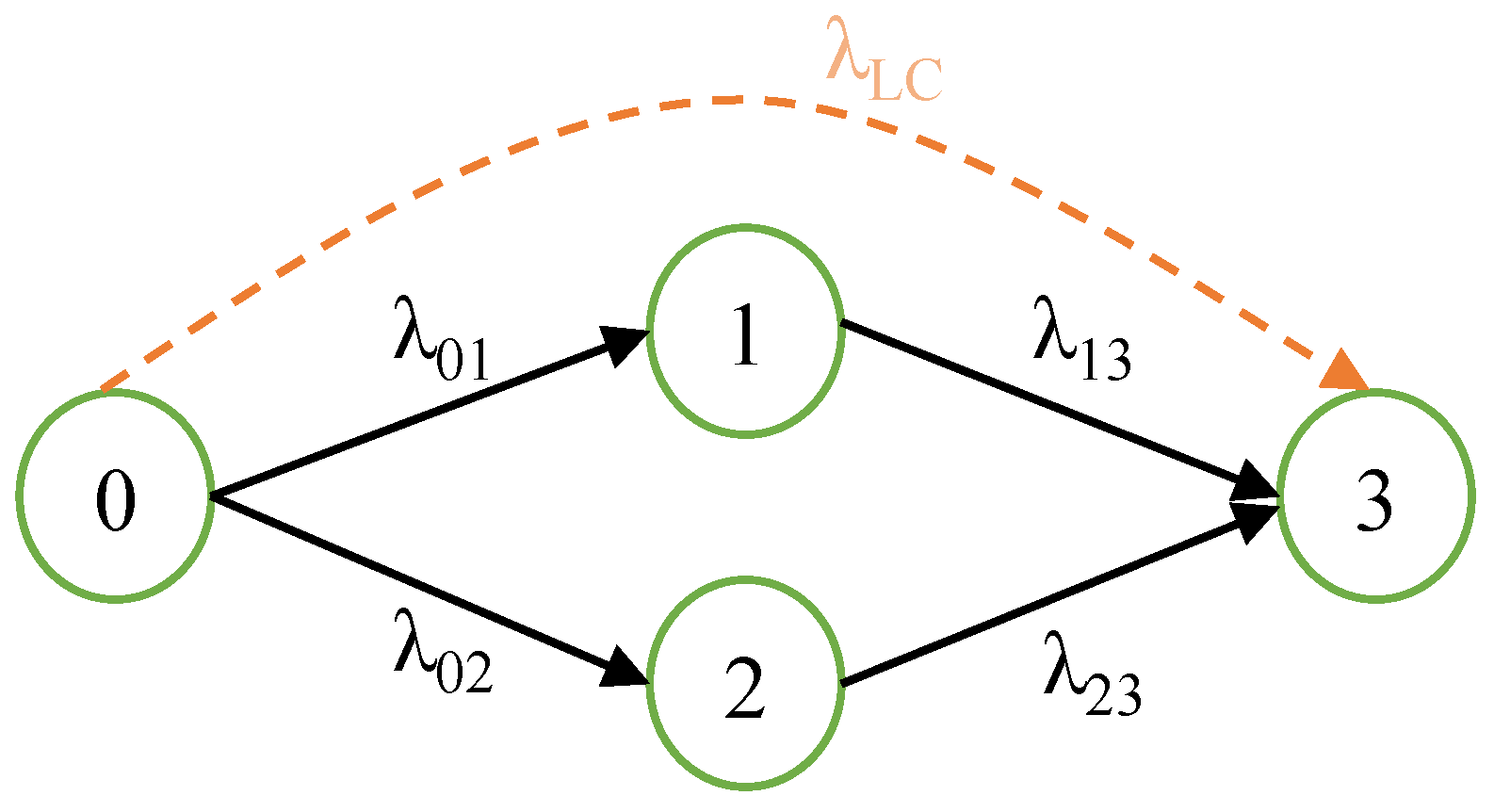
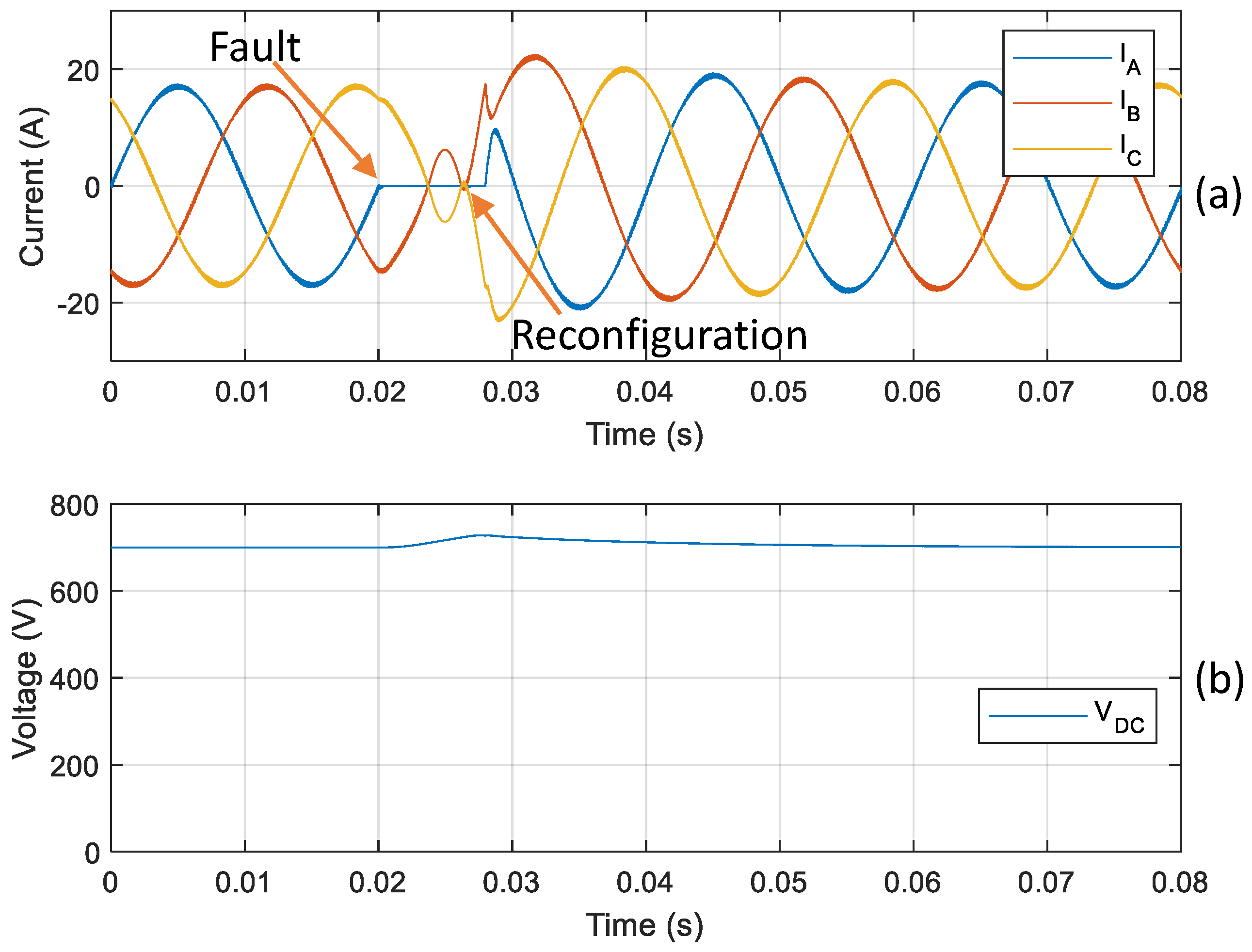
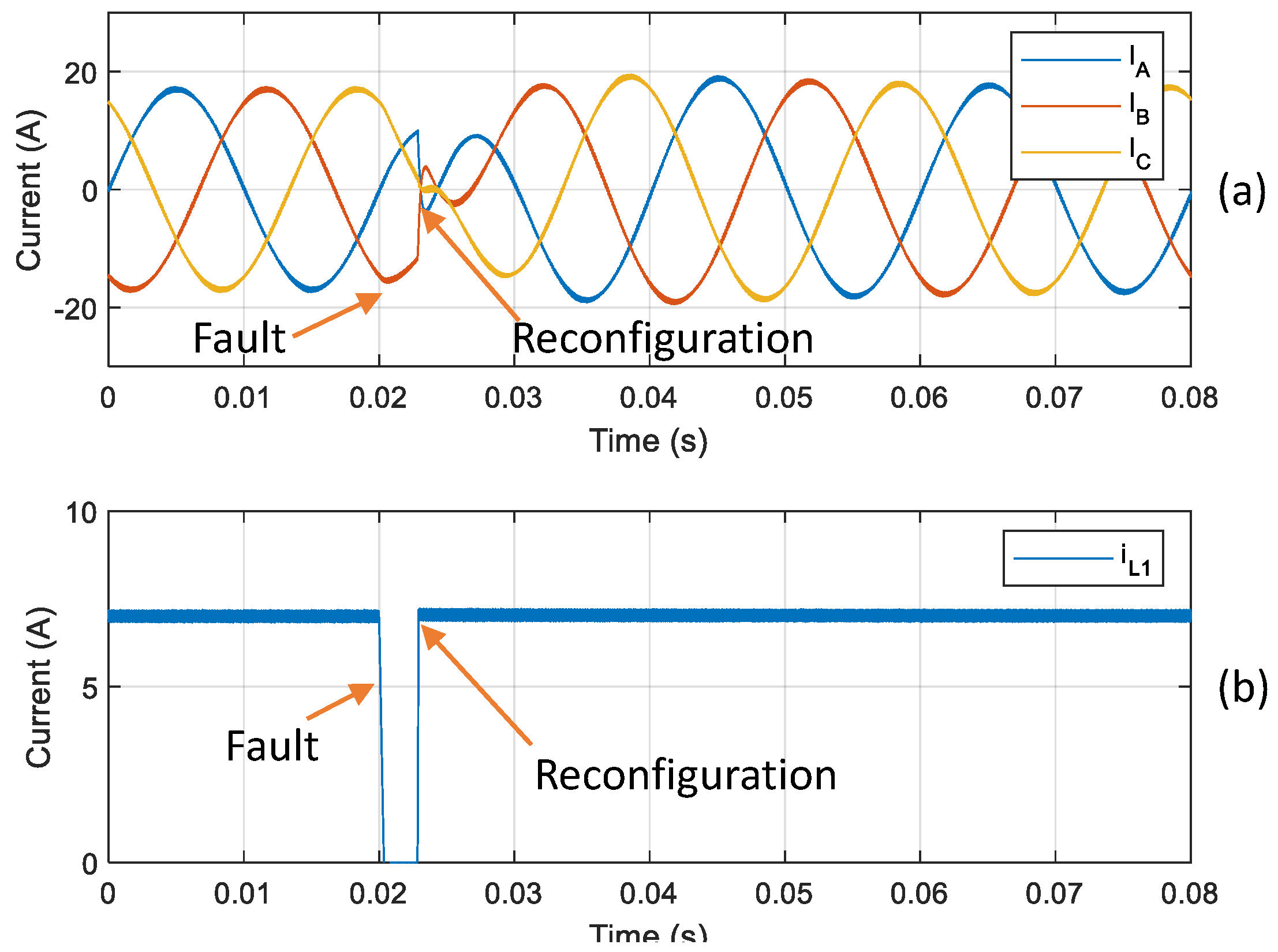
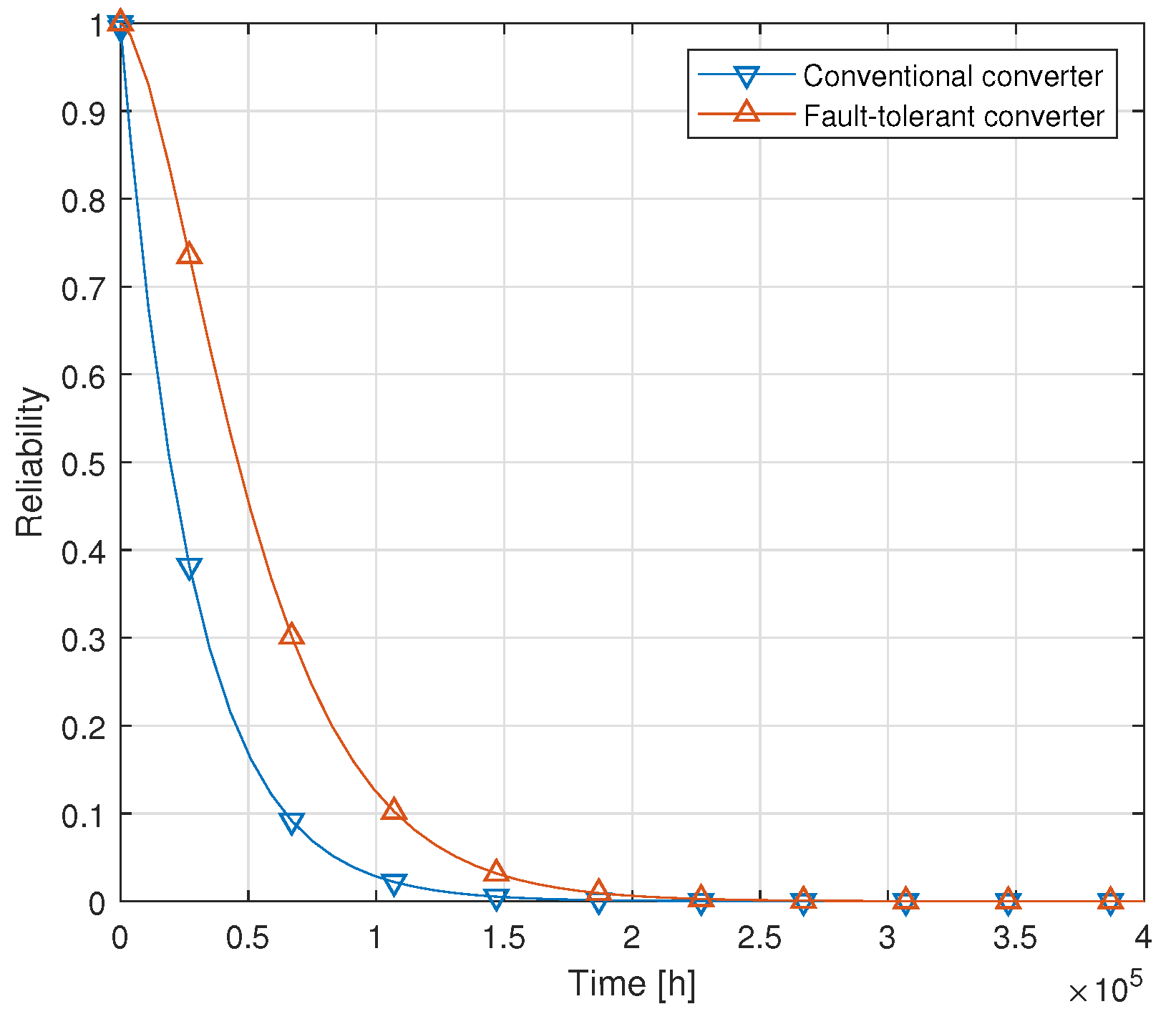
| Component | Total Number of Elements | Reference | Comments |
|---|---|---|---|
| , , | 12 | ALS61A182MM550 | Two parallel strings per phase. Each string formed by two capacitors in series |
| , , | 3 | 195E50 | One inductor per phase |
| 20 | MKP1848C71010JY5 | All capacitors in parallel | |
| 3 | RTLX50 | One inductor per phase | |
| IGBTs + diodes | 11 + 14 | SKM50GB12T4 | - |
| TRIACs | 5 | SK45UT | - |
| Parameter | Value |
|---|---|
| Rated power | |
| Grid voltage | |
| DC-DC stage switching frequency | |
| DC-AC stage switching frequency | |
| Grid frequency |
| Component | Variable |
|---|---|
| , , | |
| , , | |
| , , | |
| IGBTs (DC-DC stage) | |
| IGBTs (DC-AC stage) | |
| Diodes (DC-DC stage) | |
| Diodes (DC-AC stage) | |
| Topology | MTTF |
|---|---|
| Conventional converter | 3.20 years |
| Fault-tolerant converter | 6.26 years |
Publisher’s Note: MDPI stays neutral with regard to jurisdictional claims in published maps and institutional affiliations. |
© 2020 by the authors. Licensee MDPI, Basel, Switzerland. This article is an open access article distributed under the terms and conditions of the Creative Commons Attribution (CC BY) license (http://creativecommons.org/licenses/by/4.0/).
Share and Cite
Renaudineau, H.; Paradell-Solà, P.; Trilla, L.; Filba-Martinez, A.; Cardoner, D.; Domínguez-García, J.L. Reliability Assessment of a Fault-Tolerant PV Multistring Inverter. Energies 2020, 13, 6525. https://doi.org/10.3390/en13246525
Renaudineau H, Paradell-Solà P, Trilla L, Filba-Martinez A, Cardoner D, Domínguez-García JL. Reliability Assessment of a Fault-Tolerant PV Multistring Inverter. Energies. 2020; 13(24):6525. https://doi.org/10.3390/en13246525
Chicago/Turabian StyleRenaudineau, Hugues, Pol Paradell-Solà, Lluís Trilla, Alber Filba-Martinez, David Cardoner, and José Luis Domínguez-García. 2020. "Reliability Assessment of a Fault-Tolerant PV Multistring Inverter" Energies 13, no. 24: 6525. https://doi.org/10.3390/en13246525
APA StyleRenaudineau, H., Paradell-Solà, P., Trilla, L., Filba-Martinez, A., Cardoner, D., & Domínguez-García, J. L. (2020). Reliability Assessment of a Fault-Tolerant PV Multistring Inverter. Energies, 13(24), 6525. https://doi.org/10.3390/en13246525






